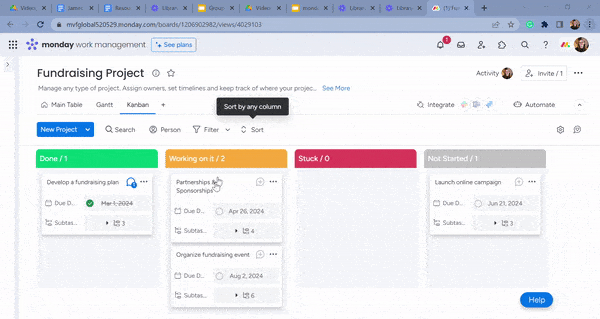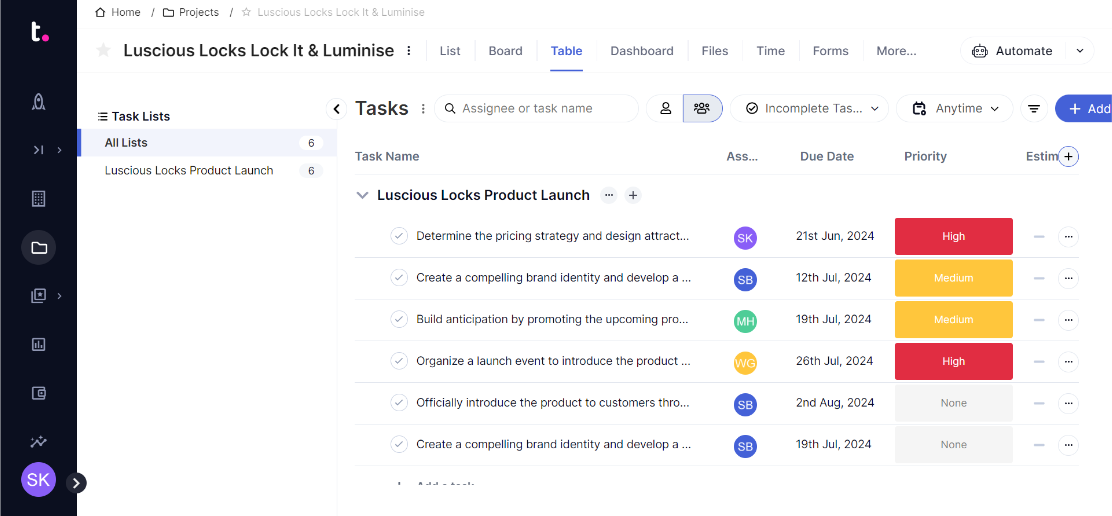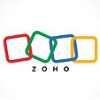The best simple project management software you can currently purchase is monday.com, which scored 4.5/5 on our most recent ease of use tests, the highest out of 10 major project management software providers we tested. monday.com has a minimalistic, clean interface that will instantly make you feel more organized, and a detailed setup process is provided on all of its plans.
What’s more, monday.com’s 24/7 live support means that if you do end up getting stuck, help is on hand right away – an assuring feature that isn’t offered by ClickUp and Asana. However, if you’ve already tried monday.com and decided it wasn’t for you, we also found Teamwork really straightforward and intuitive – creating automations was surprisingly quick and easy. It also has a great free plan.
In this guide, you’ll learn the advantages and disadvantages of the most straightforward, simple project management software platforms you can currently get your hands on.
In this guide:
- The Best Simple Project Management Software: At a Glance
- Tech.co Ease of Use Test Summary
- The Best Simple Project Management Software Reviews
- How to Choose the Best, Simple Project Management Software
- About Our Project Management Research
- Verdict: Why monday.com is the Simplest Project Management tool
- Frequently Asked Questions
| Price from All prices listed as per user, per month (billed annually) | Score The overall score obtained from our most recent round of project management software user testing | Free version | Verdict | Ease of Use | ||
|---|---|---|---|---|---|---|
| FEATURED DEAL | ||||||
| 4.4 | 4.7 | 4.6 | 4.5 | 4.3 | ||
| | | | | | ||
| A feature-rich service with two plans for enterprises, and a free tier for new users to try | A great task management system due to strong customizability and support team, with a generous free trial | A great user experience all round, with an easy-to-use automation builder and great budget tracking capabilities | A simple task-list-based project management platform with an acceptable free tier | A fairly-priced, stripped-down option, best for small teams who need a central location for basic task management | ||
| 4.1 | 4.5 | 4.3 | 4.2 | 4.1 |
The best simple project management software is monday.com, which is also our top project management software overall. It scored 4.5/5 on our most recent ease of use tests area and was quicker to set up than the 10 other providers we tested. The ease at which you can navigate around the interface and find exactly what you need is impressive.
Trello is probably the most “basic” platform included on this list, but it’s so basic that some project management tasks become quite difficult (and even impossible) to complete. With this in mind, the best project management software tools are:
monday.com – the easiest-to-use project management software
Teamwork – the best value, simple project management software
Asana– best for tracking budgets and displaying project data
Wrike – the best for large businesses and integrations
Trello – the best for customer support options
Note: All the images used in this article were taken during Tech.co’s project management user testing series. For more information on how we test project management tools, as well as other products, visit our product research page.
Test Summary
I’ve tested 10 general-use project management software tools, and monday.com’s is the simplest one you can currently get your hands on. I found the layout so much less cluttered than Jira and Smartsheet and editing aspects of the interface usually just requires a click of a button. Data you input into one project view is automatically inserted into your other project views.
I enjoyed monday.com’s guided setup process where you input answers to a number of different questions, which helps monday.com understand the kind of experience you want. But the most impressive thing about monday.com is that you don’t actually need your hand held that much once you’re past this initial phase. Building automations, for example, is really easy with monday.com’s text-based builder.
However, we’ve known for a number of years how easy monday.com is to use – I was personally most impressed with Teamwork, our second-simplest project management software. The interface is quite similar to Asana’s and Wrike’s but it just felt like it had been built a little better. There seemed to be a button, field, or column for everything I needed, and I didn’t have to consult any online resources for instructions.

The Simplest Project Management Software: Reviews
Here, we’ve dug down a little deeper into monday.com, Teamwork, and other easy-to-use project management platforms. Although monday.com is the best, they all have their merits. Trello might suit you if you’re looking for something more basic, although you may also find it a little limiting when it comes to things like collaborating with your teammates.
Why monday.com is our overall pick
Price from: $9 per user, per month
Best project management software: Overall
Ease of Use score: 4.5/5
monday.com is definitely the simplest project management software tool we’ve tested. It topped our ease-of-use tests thanks to a fantastically simple layout, unintimidating menus, and easily accessible features, as well as a fantastic customer support experience.

Pros
- Highly customizable platform
- Custom fields feature available on all plans (including the free plan)
- Rule-based automation can be used to complete simple tasks, like archiving items
Cons
- Free plan has 2-person user limit
- Limited third party integrations
- Higher tiers required for basic features
- Free plan available

- Basic: $12/user/month

- Standard: $19/user/month

monday.com impressed us the most during our most recent user testing series, scoring 4.5/5 for ease of use. It’s definitely got the clearest interface of the five included in this article, taking a much more minimalistic approach yet still providing more than 10 different board views you can use to improve your visibility over the progress of the tasks in your project.
With monday.com, I was impressed by how easy it was to build the list of automations we were using during our testing series. It was definitely the quickest and most intuitive, similar to Teamwork’s. The more granular elements of task management, like commenting on tasks and drawing dependencies, were also really simple to carry out. It took a lot longer to work this out in Zoho Projects and Smartsheet, for example.

Using monday.com’s Kanban board. Image: Tech.co’s testing process.
One downside with monday.com is that its mobile app doesn’t offer anywhere near the same level of functionality as the computer version. This isn’t a huge problem, but for employees that conduct a lot of their business on the go, it’s something to think about.
However, other than that, it really is a stellar choice. It’s very accessible to newbies, especially compared to providers like Smartsheet, and you can gently ease yourself into using features that’ll help you save time, like the automation builder.
I had a great experience with the customer support options, opting to use the live chat function to solve an issue I was having during testing. I was promptly sent a video by a member of monday.com’s support team showing me exactly where I was going wrong. This helped me to solve the issue within minutes, with no real effort on my side, and no need to consult community forums.
And what’s more – monday.com routinely rolls out new updates, so you can rest assured that your investment will go far. In August 2024, for instance, the platform debuted features that allow users to exclude or include weekend days from their task managing, save progress while completing forms, and export canvases to print-ready PDFs.
monday.com pricing
When it comes to monday.com pricing, there are five plans in total. We’ve outlined them below.
- First up is the free plan which has a user limit of two, and doesn’t have enough tools to cater to the project management needs of large businesses.
- The next plan, the Basic plan, costs just $9 per user, per month – a data dashboard is added, but there’s still no automation builder or any integration capabilities. However, it’ll still be more than enough for a small team looking for simple project management software.
- The Standard plan is priced from $12 per user, per month, and it’s the first plan that includes a Gantt chart.
- The Pro plan ($19 per user, per month) is geared toward medium-sized and large businesses.
- monday.com also has an Enterprise plan (custom pricing) which is similar to the Pro plans but includes extra support during onboarding and advanced security features like IP restriction.

Using monday.com’s automation builder. Image: Tech.co’s Testing Process.
Why Teamwork is the best value
Price From: $10.99 per user, per month
Best for: building automations, great free plan
Ease of Use score: 4.3/5
Teamwork came second overall in our last round of project management ease-of-use testing, and really ran monday.com close.

Pros
- Lots of collaboration tools
- Kanban-style boards and Gantt charts available
- Affordable pricing and solid free option
- Great security options
Cons
- Limited built-in integrations
- Data visualization isn't the easiest
- Free plan available

- Deliver: $10.99/user/month

- Grow: $19.99/user/month

While it might not be quite as easy on the eye, Teamwork is an excellent alternative to monday.com. It came 6th out of 14 project management software platforms we tested back in 2022, but the user experience has significantly improved since then, seeing it rise to second place.
I really enjoyed using the automation builder. There were so many good examples provided, but actually just building one yourself was pretty straightforward as well, thanks to the instructions provided by Teamwork. I also liked the way you could quickly access just your own tasks with a “my tasks” button at the top of the screen, and how easy it was to draw dependencies between tasks.

Teamwork’s Table view. Image: Tech.co’s Testing Process.
The other great thing about Teamwork is its free plan, which includes a lot of the task management features excluded from the cheaper plans of other software. For instance, phone-based support, a custom automation builder, and time tracking, which can give you valuable insights into who your star performers are. This helped the platform to a 4.3/5 score for task management.
Teamwork pricing
Teamwork scores 4.4/5 for pricing and as we said above, is the best value simple project management software we’ve tested. Read on for a full breakdown of the different pricing tiers.
- The free plan is impressively feature-rich, especially compared to monday.com.
- The Deliver plan ($9.99 per user, per month) will be the best option for medium-sized teams looking for a highly capable project management solution that packages a lot of features into a relatively simple interface. In terms of core features it’s quite similar to the Starter plan, but guest access is added.
- The Grow ($19.99 per user, per month) plan includes a resource management tool for managing your team members’ capacity.
- The Scale plan will be suited to enterprises (custom pricing) that need onboarding support.
Why Asana is best for tracking budgets
Price from: $10.99 per user, per month
Best for: tracking budgets and displaying project data
Ease of Use score: 4.2/5
Asana came third on our ease-of-use tests, and all things considered is a very similar program to Teamwork. We found budget tracking relatively easy, while uploading data and building charts on the project dashboard was simpler with Asana than most other competitors.

Pros
- Unlimited storage
- Plenty of third-party integrations
- Incredibly clean and intuitive interface
- Easy-to-use dashboards and chart builder
Cons
- Most key features require an Advanced plan
- Very high prices for larger teams
- No phone-based support
- Free plan available

- Starter: $10.99/user/month

- Advanced: $24.99/user/month

- Enterprise: Custom pricing

Asana’s layout is pretty similar to Teamwork’s – although it felt a little more cramped when we opened a task window and tried to edit tasks. But aside from that, Asana was a breeze to use – only monday.com and Teamwork took us less time to set up.
There’s also a lot of help provided for you along the way.
“It seemed to suggest what the best [task] dependencies were,” – Tech.co researcher Ollie Simpson, who participated in our project management user testing.
This was in reference to the way Asana will analyze your tasks and intelligently suggest organizational changes that’ll make your life easier.
One thing I really liked about Asana was how easy it was to add budgeting information. Budgets can be assigned to individual tasks at the click of a mouse, whereas some providers will only let you set a budget for an entire project as a whole.

Managing tasks in Asana. Image: Tech.co’s testing process.
One downside to Asana is the price tag – the Business plan costs $24.99 per user, per month. With that money, you could buy Trello’s Enterprise plan and have enough left over for Teamwork’s Starter plan. It’s not that competitive, with ClickUp, Zoho Projects, Jira, monday.com and Teamwork all offering cheaper, similar plans.
Asana pricing
You can find information about the Asana plans below.
- Asana has a free plan with a user limit of 15, but in terms of features, it’s quite a bit more basic than Teamwork and even monday.com. For example, there’s no automation builder and none of Asana’s impressive tools for displaying your project data.
- Asana’s Starter plan costs $10.99 per user, per month, which is nearly three times as much as Zoho’s Premium plan. In fact, it’s the most expensive first-paid plan on this list, and while a lot of task management features are added in, there are much cheaper options.
- Asana’s Business plan is even more powerful and includes its automation builder, a resource management tool, and a time-tracking feature for tasks. However, at $24.99 per user, per month, it’s even more expensive than Wrike’s Business plan.
For more information on Asana’s business and Enterprise plans, and hidden costs, check out this guide to Asana pricing.
Why Wrike is best for large businesses and integrations
Price From: $10 per user, per month
Best for: Large businesses
Ease of Use score: 4.1/5
Wrike can be used to manage highly complex projects, yet still remains one of the simpler project management platforms for larger businesses. However, we ran into a few more issues during user testing which knocked off marks earned by monday.com and Teamwork.

Pros
- No-nonsense, robust feature catalog
- Lots of customizability
- Strong task management and data tools
- Huge integrations library
Cons
- Not entirely easy to use
- Difficult to use automation builder
- Not the best for collaboration
- Free plan available

- Team: $10/user/month

- Business: $25/user/month

Wrike scored 4.1/5 on our ease of use tests, which is higher than providers like ClickUp and Jira, but not quite as good as Teamwork. While testing the platform, I found the initial setup was really smooth, and ran into very few issues.
A lot of the things that were further down on the list of tasks we put together to test project management platforms we completed during the setup. Everything was quite intuitive with Wrike.
Although the setup was quick, when I started to use some of the platform’s more powerful features, it became more complicated and I felt a little bit like I was running into dead ends. The automation builder, for instance, was nowhere near as intuitive as monday.com’s. There were a couple of simple things the platform just seemed to struggle to turn into a rule.

Editing a task in Wrike. Image: Tech.co’s Testing Process.
If you’ve got a little bit more time on your hands to set Wrike up and tinker with some of the settings, it won’t take you ages to get to grips with. The analytics view auto-populates itself with project data, while the Table view is very clear and the task management features were as good as ClickUp’s.
It’s worth noting that Wrike scores really highly for integrations (5/5). It offers a really wide range of finance, marketing, CRM, email and communications integrations, making it easy to transfer data between different apps.
Wrike pricing
Find out about Wrike’s pricing plans below.
- Wrike’s free plan is similar to monday.com’s – there’s no Gantt chart, and other core features are missing. There’s no user limit though, meaning it can be theoretically used by teams of any size.
- The Team plan is Wrike’s first paid plan and retails at $10 per user, per month, making it more expensive than Teamwork and Trello’s first paid plans. Features like a form builder and custom fields are included, so this is a much better plan for teams managing complicated tasks than the free plan.
- Wrike’s Business plan costs $24.80 per user, per month, and thanks to Wrike’s huge range of integrations, will slot nicely into your current technical stack – at least compared to providers like Trello, which have fewer integrations.
Wrike is a great option for really large businesses because of the Enterprise plan and the Pinnacle plan, thanks to advanced security features like IP restriction. Check out our Wrike pricing guide for more analysis of the provider’s plans.
Why Trello is best for customer support options
Price From: $5 per user, per month
Best for: Customer support
Ease of Use score: 4.1/5
Trello performed well on our ease-of-use tests compared to many of the Trello alternatives we also tested. It’s a lot more basic than the other four provided on this list, and therefore, it’s not quite as useful. However, if you’re looking for a very basic program for tracking straightforward tasks, it might be the best option.

Pros
- Kanban-dominant approach
- Automation is available on the free plan
- Cheaper than most competitors
- Live chat support on all paid plans
Cons
- Very simple project templates
- Basic functionality, not updated regularly
- Sparse collaboration tools
- Free plan available

- Standard: $5/user/month

- Premium: $10/user/month

Trello is a really basic program compared to the other project management providers featured in this article. In 2023, it was our best platform for basic task management, because it doesn’t overwhelm you with features or drag you through a long setup process, so it’s ideal for teams who just want a central location to store all of their tasks.
That being said, more powerful project management tools like monday.com are now showing that you can do both. It is possible to provide a simple, easy-to-navigate interface and features needed to manage really complex, multi-stage projects with hundreds of tasks. Not every business will need this, but it’s worth understanding that Trello just isn’t that scalable.
Trello isn’t updated as much as the likes of monday.com and Asana, so it’s unlikely you’ll have a layout or design change sprung on you.
Trello is the best project management software when it comes to customer support, scoring a perfect 5/5. On the Enterprise plan, you’ll have access to phone-based support, 24/7 live support, and onboarding assistance to get you up and running. However, several core features provided by every other provider on this list – such as task dependencies – are nowhere to be seen.

Editing a task card on Trello’s Kanban board. Image: Tech.co’s testing process.
Trello pricing
Trello is one of the cheapest options on the market. Find out more below.
- Trello comes with a free plan, and considering its paid software is relatively limited, you may expect the free plan to be even more restrictive.
- There’s also a Premium plan available for $5 per user, per month, which makes it the cheapest paid plan featured on this list, narrowly beating Teamwork’s $5.99 per user, per month Starter plan. Trello’s offering is nowhere near as feature-rich, however.
- Trello is a bit of an outlier in the project management software world because it makes its Enterprise plan pricing public. Trello’s Enterprise plan costs just $17.50 per user, per month, which is cheaper than Wrike and Asana’s business plans, and just slightly more expensive than monday.com’s Pro projects plan.
How to Choose Simple Project Management Software
If you’re set on a simple project management software program, that certainly narrows it down – but there are still more things to consider when purchasing project management software. Some of the key things that you should prioritize if you’re looking for simple project management software include:
- A tidy interface that won’t get confusing
- A speedy setup process
- Intuitive editing tools
- A Kanban board
- Lack of technical/industry-specific jargon
- Detailed feature walkthroughs
- Live chat function/24/7 support
- Kanban board and Gantt chart view
- A “My Tasks” area
- Integrations with lots of other software
Your final choice might not have every single one of the features above, but if you find a provider that doesn’t have any of these, it might prove a little difficult to use.
About Our Research
At Tech.co, we spend a lot of our time researching and testing software and services before we review them – it’s the only way we can say with confidence whether a product is worth recommending to you. This involves hours of market research and interviews with businesses that read our content, plus rigorous user testing procedures using criteria we’ve created ourselves.
A big part of our project management software research is the ease of use tests we perform. During these tests, a group of up to eight participants use mock data to set up a project using each of the 10 major providers that we’re looking at. We looked at how long it took to import project data and set up our projects, and how easy it was to utilize different functions of the software.
Along with Ease of Use testing, we focused on five other areas of inquiry: Security, Integrations, Pricing, Customer Support, and Functionality. “Functionality” is broken down into four sub-areas: task management, data visualization, workflow creation, and collaboration.
Although we maintain commercial partnerships with some of the manufacturers of the products we write about, this does not – and will never – influence how we order products in our ranked lists, or the conclusions we draw in comparative head-to-heads. In fact, it’s our independent research that allows us to remain editorially independent.
Verdict: Why monday.com is the Best Simple Project Management Software
The simplest project management software you can use is monday.com. Its straightforward, unintimidating layout makes everything much clearer and simpler than providers that bombard you with features that you may never use. monday.com, as one member of our testing group commented, feels like an Apple product – the user experience is clearly the priority.
monday.com has an incredibly easy-to-use, text-based automation builder, and switching between different project views is a breeze. Pulling out data from your project and using it to gain insights into how your team is progressing can sometimes feel like an arduous task. However, monday.com actually scores 5/5 for data visualization thanks to its chart builder and numerous preset widget options.
We’d also recommend Teamwork if you’d like a more “classic”-looking general-use project management tool. It looks similar to Asana but has a simpler automation builder and the interface didn’t feel as cluttered. It was also really easy to access my own tasks, which I struggled a little bit to find in some of the other tools we tested.









